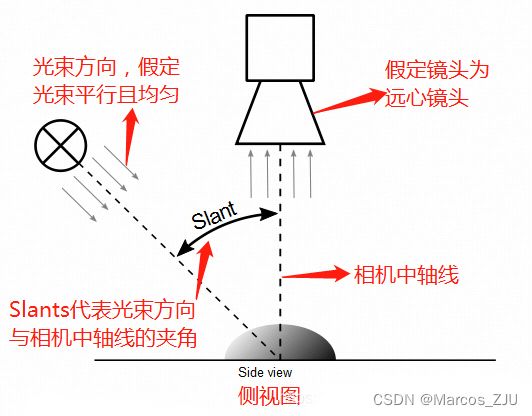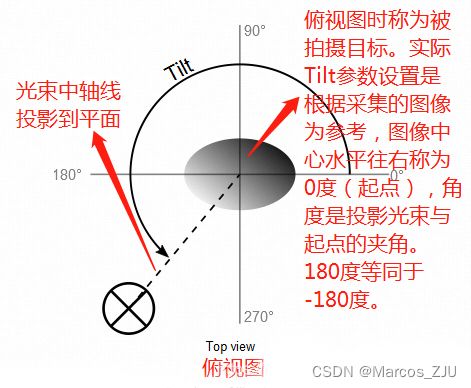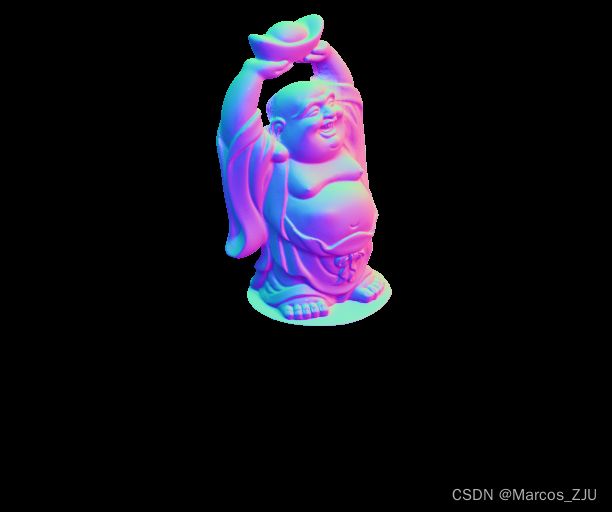计算机视觉:朗伯光度立体法(Lambertian Photometric Stereo)
计算机视觉:朗伯光度立体法(Lambertian Photometric Stereo)
- 光度立体法简介
- 朗伯光度立体法算法原理
- 朗伯光度立体法matlab程序
- 示例
-
- Albedo图
- Normal图
- Re_rendered图
- 参考文献
光度立体法简介
光度立体法,即Photometric Stereo, 最早是由当时在MIT的人工智能实验室的Robert J. Woodham教授在1978年左右提出。他在1979年的论文《Photometric stereo: A reflectance map technique for determining surface orientation from image intensity》,以及1980年的论文《Photometric Method for Determining Surface Orientation from Multiple Images》中比较系统的阐述了整套理论框架。光度立体法可以根据二维纹理信息提取出三维模型,其典型应用是检测物体表面微小变化。
朗伯光度立体法基于Woodham算法,Woodham在论文中提出三个基本假设。在这三个基本假设下完成整套理论框架的推演。这三个基本假设分别是:
- 假定相机是无畸变成像,也就是说必须使用远心镜头或者长焦镜头。
- 假定每一个光源发射的光束都是平行且均匀的,也就是说必须使用具有均匀强度的远心照明光源,或者使用远距离的点光源代替。
- 物体必须具有朗伯(lambertian)反射特性,即它必须以漫反射的方式反射入射光。
朗伯光度立体法的大致思路是:
当相机和目标物体相对位置固定不变时,使用不同方向的光源照射同一目标物体,相机可以拍摄到目标物体带有不同明暗分布的图像(至少需要三张图),再通过求解基于朗伯反射原理的反射方程组,求解目标表面的法向分布或者albedo图。
带有远心镜头的相机必须与被测物体表面垂直安装,在采集多幅图像时,一定要保证相机和物体不被移动。相反,对于采集至少三张的灰度图像,其每次取像的照明方向必须改变(相对于相机)。对于采集的多张图像中的每一幅图,照明方向必须指定Slants和Tilts两个参数角度,其描述了相对于当前场景的光照角度。为了更好的理解这两个参数含义,我们假定光源射出的光束是平行光,镜头是远心镜头,相机垂直于物体表面。


朗伯光度立体法算法原理
根据Lambert模型:
I = ρ L ⋅ N \textbf{I} = \rho\ \textbf{L}\cdot\textbf{N} I=ρ L⋅N
式中, ρ \rho ρ 为表面反射率(albedo),其值介于0 - 1之间,反映了物体表面特性; N \textbf{N} N 为表面法线(normal); L \textbf{L} L 为照明方向。将 ρ \rho ρ 和 N \textbf{N} N 合并起来用 G \textbf{G} G来表示,则有:
I = L T G . \textbf{I} = \textbf{L}^T\textbf{G}. I=LTG.
每个像素位置对应的 G \textbf{G} G是三维向量(方向为normal,模长为albedo),因此单个光源无法求解该方程,至少需要三个不同位置的光源,求解得到三个未知量。
由最小二乘法:
min G ∣ ∣ I − L T G ∣ ∣ 2 \mathop{\min}\limits_{\textbf{G}} ||\textbf{I}-\textbf{L}^T\textbf{G}||^2 Gmin∣∣I−LTG∣∣2
可以求得:
G = ( L L T ) − 1 LI \textbf{G} = (\textbf{L}\textbf{L}^T)^{-1}\textbf{L}\textbf{I} G=(LLT)−1LI
我们求得 G \textbf{G} G 的模长就是albedo:
ρ = ∣ ∣ G ∣ ∣ \rho = ||\textbf{G}|| ρ=∣∣G∣∣
G \textbf{G} G 归一化后的单位向量矩阵就是normal:
N = G ∣ ∣ G ∣ ∣ \textbf{N} = \frac{\textbf{G}}{||\textbf{G}||} N=∣∣G∣∣G
朗伯光度立体法matlab程序
注:此代码只涉及核心算法,不包含数据的读入,与结果的输出。
function [Albedo, Normal, Re_rendered] = Photometric_Stereo(data)
assert(size(data.imgs, 1)==size(data.s, 1), 'Size mismatched!');
num = size(data.imgs, 1);
% Get image dimensions
im = data.imgs{1};
[im_h, im_w, ~] = size(im);
% Initialize T, a im_h-by-im_w-by-num matrix, whose (h, w, :) holds
% the intensities at (h, w) for all p different lightings
im_T = zeros(im_h, im_w, num);
% Initialize im_R, a im_h-by-im_w-by-num matrix
im_R = zeros(im_h, im_w, num);
% Initialize im_G, a im_h-by-im_w-by-num matrix
im_G = zeros(im_h, im_w, num);
% Initialize im_B, a im_h-by-im_w-by-num matrix
im_B = zeros(im_h, im_w, num);
% For each image
for idx = 1:num
im = data.imgs{idx};
imGray = rgb2gray(im);
% Loop thru each pixel
for h = 1:im_h
for w = 1:im_w
% If in the mask
if data.mask(h, w)
im_R(h, w, idx) = im(h, w, 1);
im_G(h, w, idx) = im(h, w, 2);
im_B(h, w, idx) = im(h, w, 3);
im_T(h, w, idx) = imGray(h,w);
end
end
end
end
% Initialize Normal, a im_h-by-im_w-by-3 matrix
Normal = zeros(im_h, im_w, 3);
% Initialize Albedo, a im_h-by-im_w-by-1 matrix
Albedo = zeros(im_h, im_w, 3);
% Initialize Re_rendered, a im_h-by-im_w-by-3 matrix
Re_rendered = zeros(im_h, im_w, 3);
% Loop thru each location
for h = 1:im_h
for w = 1:im_w
% If in the mask
if data.mask(h, w)
%% Normal
% Lightings
L = data.s;
% Intensities
I = reshape(im_T(h, w, :), [num, 1]);
% Dealing with shadows and highlights
for k = 1:10
max_index = find(I==max(I));
I(max_index) = [];
L(max_index,:) = [];
min_index = find(I==min(I));
I(min_index) = [];
L(min_index,:) = [];
end
% Solve surface normals and albedo
G = (L.'*L)\(L.'*I);
if norm(G) ~= 0
% Normalize n
n = G./norm(G);
else
n = [0; 0; 0];
end
% Save
Normal(h, w, :) = n;
%% Albedo
% a_R
L = data.s;
I_R = reshape(im_R(h, w, :), [num, 1]);
for k = 1:10
max_index = find(I_R==max(I_R));
I_R(max_index) = [];
L(max_index,:) = [];
min_index = find(I_R==min(I_R));
I_R(min_index) = [];
L(min_index,:) = [];
end
G_R = (L.'*L)\(L.'*I_R);
a_R = norm(G_R);
Albedo(h, w, 1) = a_R;
% a_G
L = data.s;
I_G = reshape(im_G(h, w, :), [num, 1]);
for k = 1:10
max_index = find(I_G==max(I_G));
I_G(max_index) = [];
L(max_index,:) = [];
min_index = find(I_G==min(I_G));
I_G(min_index) = [];
L(min_index,:) = [];
end
G_G = (L.'*L)\(L.'*I_G);
a_G = norm(G_G);
Albedo(h, w, 2) = a_G;
% a_B
L = data.s;
I_B = reshape(im_B(h, w, :), [num, 1]);
for k = 1:10
max_index = find(I_B==max(I_B));
I_B(max_index) = [];
L(max_index,:) = [];
min_index = find(I_B==min(I_B));
I_B(min_index) = [];
L(min_index,:) = [];
end
G_B = (L.'*L)\(L.'*I_B);
a_B = norm(G_B);
Albedo(h, w, 3) = a_B;
%% Re_rendered
Re_rendered(h, w, :) = [a_R;a_G;a_B]*dot(n,[0;0;1]);
end
end
end
示例
Albedo图
Normal图
Re_rendered图
在照明方向和观察方向一致时,利用normal和albedo图重新渲染的图片:
参考文献
光度立体简介
Halcon 光度立体法(photometric_stereo)详解z


